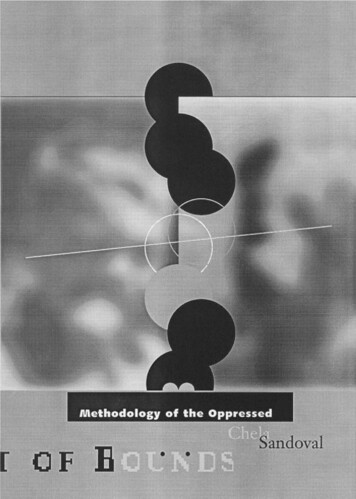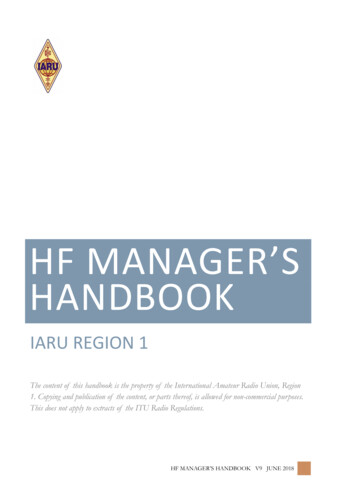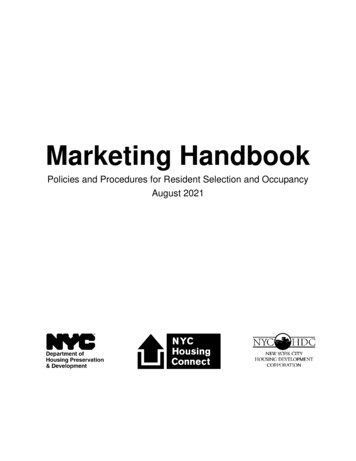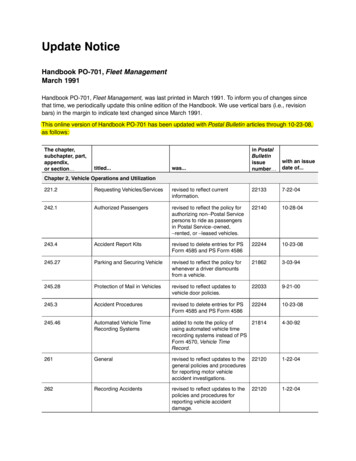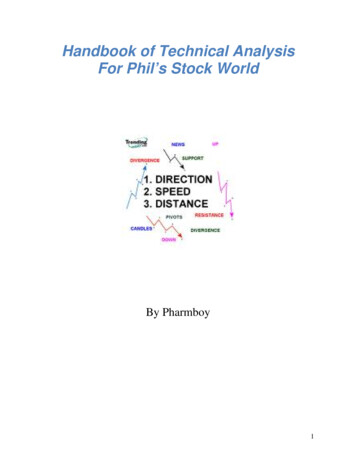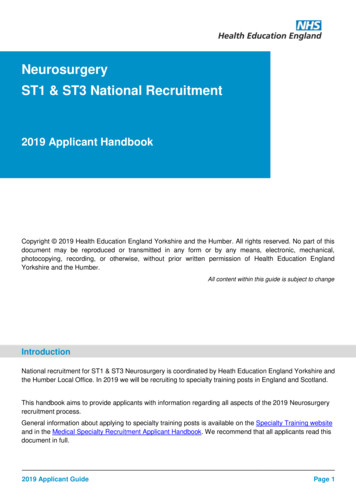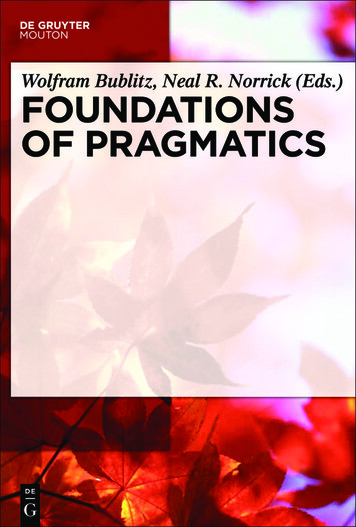
Transcription
Foundations of PragmaticsHoPs 1
Handbooks of PragmaticsEditorsWolfram BublitzAndreas H. JuckerKlaus P. SchneiderVolume 1De Gruyter Mouton
Foundations of PragmaticsEdited byWolfram BublitzNeal R. NorrickDe Gruyter Mouton
ISBN 978-3-11-021425-3e-ISBN 978-3-11-021426-0Library of Congress Cataloging-in-Publication DataFoundations of pragmatics / edited by Wolfram Bublitz, Neal R.Norrick.p. cm. (Handbook of pragmatics; 1)Includes bibliographical references and index.ISBN 978-3-11-021425-3 (alk. paper)1. Pragmatics. I. Bublitz, Wolfram. II. Norrick, Neal R.P99.4.P72F68 20114011.45 dc222011013980Bibliographic information published by the Deutsche NationalbibliothekThe Deutsche Nationalbibliothek lists this publication in the Deutsche Nationalbibliografie;detailed bibliographic data are available in the Internet at http://dnb.d-nb.de.” 2011 Walter de Gruyter GmbH & Co. KG, Berlin/BostonCover image: Vetta Collection/iStockphotoTypesetting: Dörlemann Satz GmbH & Co. KG, LemfördePrinting: Hubert & Co. GmbH & Co. KG, Göttingen Printed on acid-free paperPrinted in Germanywww.degruyter.com
Preface to the handbook seriesWolfram Bublitz, Andreas H. Jucker and Klaus P. SchneiderThe series Handbooks of Pragmatics, which comprises nine self-contained volumes, provides a comprehensive overview of the entire field of pragmatics. It ismeant to reflect the substantial and wide-ranging significance of pragmatics as agenuinely multi- and transdisciplinary field for nearly all areas of language description, and also to account for its remarkable and continuously rising popularityin linguistics and adjoining disciplines.All nine handbooks share the same wide understanding of pragmatics as thescientific study of all aspects of linguistic behaviour. Its purview includes patternsof linguistic actions, language functions, types of inferences, principles of communication, frames of knowledge, attitude and belief, as well as organisationalprinciples of text and discourse. Pragmatics deals with meaning-in-context, whichfor analytical purposes can be viewed from different perspectives (that of thespeaker, the recipient, the analyst, etc.). It bridges the gap between the system sideof language and the use side, and relates both of them at the same time. Unlike syntax, semantics, sociolinguistics and other linguistic disciplines, pragmatics is defined by its point of view more than by its objects of investigation. The former precedes (actually creates) the latter. Researchers in pragmatics work in all areas oflinguistics (and beyond), but from a distinctive perspective that makes their workpragmatic and leads to new findings and to reinterpretations of old findings. Thefocal point of pragmatics (from the Greek prãgma ,act’) is linguistic action (andinter-action): it is the hub around which all accounts in these handbooks revolve.Despite its roots in philosophy, classical rhetorical tradition and stylistics, pragmatics is a relatively recent discipline within linguistics. C.S. Peirce and C. Morrisintroduced pragmatics into semiotics early in the twentieth century. But it was notuntil the late 1960s and early 1970s that linguists took note of the term and beganreferring to performance phenomena and, subsequently, to ideas developed and advanced by Wittgenstein, Ryle, Austin and other ordinary language philosophers.Since the ensuing pragmatic turn, pragmatics has developed more rapidly and diversely than any other linguistic discipline.The series is characertised by two general objectives. Firstly, it sets out to reflect the field by presenting in-depth articles covering the central and multifarioustheories and methodological approaches as well as core concepts and topics characteristic of pragmatics as the analysis of language use in social contexts. All articles are both state of the art reviews and critical evaluations of their topic in thelight of recent developments. Secondly, while we accept its extraordinary complexity and diversity (which we consider a decided asset), we suggest a definitestructure, which gives coherence to the entire field of pragmatics and provides
viWolfram Bublitz, Andreas H. Jucker and Klaus P. Schneiderorientation to the user of these handbooks. The series specifically pursues the following aims:– it operates with a wide conception of pragmatics, dealing with approaches thatare traditional and contemporary, linguistic and philosophical, social and cultural, text- and context-based, as well as diachronic and synchronic;– it views pragmatics from both theoretical and applied perspectives;– it reflects the state of the art in a comprehensive and coherent way, providing asystematic overview of past, present and possible future developments;– it describes theoretical paradigms, methodological accounts and a largenumber and variety of topical areas comprehensively yet concisely;– it is organised in a principled fashion reflecting our understanding of the structure of the field, with entries appearing in conceptually related groups;– it serves as a comprehensive, reliable, authoritative guide to the central issuesin pragmatics;– it is internationally oriented, meeting the needs of the international pragmaticcommunity;– it is interdisciplinary, including pragmatically relevant entries from adjacentfields such as philosophy, anthropology and sociology, neuroscience and psychology, semantics, grammar and discourse analysis;– it provides reliable orientational overviews useful both to students and moreadvanced scholars and teachers.The nine volumes are arranged according to the following principles. The firstthree volumes are dedicated to the foundations of pragmatics with a focus on microand macro units: Foundations must be at the beginning (volume 1), followed bythe core concepts in pragmatics, speech actions (micro level in volume 2) and discourse (macro level in volume 3). The following three volumes provide cognitive(volume 4), societal (volume 5) and interactional (volume 6) perspectives. Theremaining three volumes discuss variability from a cultural and contrastive (volume 7), a diachronic (volume 8) and a medial perspective (volume 9):1. Foundations of pragmaticsWolfram Bublitz and Neal R. Norrick2. Pragmatics of speech actionsMarina Sbisà and Ken Turner3. Pragmatics of discourseKlaus P. Schneider and Anne Barron4. Cognitive pragmaticsHans-Jörg Schmid5. Pragmatics of societyGisle Andersen and Karin Aijmer
Preface to the handbook series6. Interpersonal pragmaticsMiriam A. Locher and Sage L. Graham7. Pragmatics across languages and culturesAnna Trosborg8. Historical pragmaticsAndreas H. Jucker and Irma Taavitsainen9. Pragmatics of computer-mediated communicationSusan Herring, Dieter Stein and Tuija Virtanenvii
AcknowledgementsThis initial, foundational volume in this series of handbooks represents the work ofa large number of individuals over a fairly long period of time. We must, of course,thank our contributors for producing high quality articles reflecting scholarly rigorand a strong sense of what our readers seek in a handbook of this scope. Withoutconscientious, willing reviewers, projects like this are simply impossible. Our sincere thanks go out to all our reviewers, though we cannot identify them by name.We editors are surrounded by competent, trustworthy staff in Augsburg and Saarbrücken, Germany. We own a debt of gratitude to Claudia Enzweiler for proofreading and Sylvia Monzon for her clerical services, to Katharina Rüters, Katrin Stuisand Claudia Rieger for their help with the desk editing and compilation of the indexes. Finally, we are grateful to the De Gruyter team: Barbara Karlson, WolfgangKonwitschny and Anke Beck.
Table of contentsPreface to the handbook series . . . . . . . . . . . . . . . . . . . . . . . .Acknowledgements . . . . . . . . . . . . . . . . . . . . . . . . . . . . . .vixIntroduction: the burgeoning field of pragmaticsWolfram Bublitz and Neal R. Norrick . . . . . . . . . . . . . . . . . . . . .1Part I – Conceptual foundations1.2.3.4.Pragmatics as a linguistic conceptAnita Fetzer . . . . . . . . . . . . . . . . . . . . . . . . . . . . . . .23Micropragmatics and macropragmaticsPiotr Cap . . . . . . . . . . . . . . . . . . . . . . . . . . . . . . . .51Pragmalinguistics and sociopragmaticsSophia Marmaridou . . . . . . . . . . . . . . . . . . . . . . . . . .77MetapragmaticsAxel Hübler . . . . . . . . . . . . . . . . . . . . . . . . . . . . . . . 107Part II – Theoretical foundations5.The rise of pragmatics: a historiographic overviewWataru Koyama . . . . . . . . . . . . . . . . . . . . . . . . . . . . . 1396.Semiotic foundations of pragmaticsWinfried Nöth . . . . . . . . . . . . . . . . . . . . . . . . . . . . . . 1677.Pragmatics in modern philosophy of languageNikola Kompa and Georg Meggle . . . . . . . . . . . . . . . . . . . 2038.Foundations of pragmatics in functional linguisticsSaskia Daalder and Andreas Musolff . . . . . . . . . . . . . . . . . . 2299.Foundations: ethnomethodology and Erving GoffmanChristine Domke and Werner Holly . . . . . . . . . . . . . . . . . . 261
xiiTable of contents10.Pragmatics in Habermas’ Critical Social TheoryMaeve Cooke . . . . . . . . . . . . . . . . . . . . . . . . . . . . .289Part III – Key topics in pragmatic description11.12.13.14.Deixis and indexicalityWilliam F. Hanks . . . . . . . . . . . . . . . . . . . . . . . . . . . .315Reference and anaphoraMonika Schwarz-Friesel and Manfred Consten . . . . . . . . . . . .347Speech actsElena Collavin . . . . . . . . . . . . . . . . . . . . . . . . . . . . .373Types of inference: entailment, presupposition, and implicatureYan Huang . . . . . . . . . . . . . . . . . . . . . . . . . . . . . . .397Part IV – The place of pragmatics in the description of discourse15.16.17.18.Pragmatics and grammarArnulf Deppermann . . . . . . . . . . . . . . . . . . . . . . . . . .425Pragmatics and semanticsJohn Saeed . . . . . . . . . . . . . . . . . . . . . . . . . . . . . . .461Pragmatics and prosody: prosody as social actionElizabeth Couper-Kuhlen . . . . . . . . . . . . . . . . . . . . . . .491Pragmatics and literatureJacob L. Mey . . . . . . . . . . . . . . . . . . . . . . . . . . . . . .511Part V – Methods and tools19.20.Approaching the data of pragmaticsMonika Bednarek . . . . . . . . . . . . . . . . . . . . . . . . . . .537Experimental pragmaticsRichard Breheny . . . . . . . . . . . . . . . . . . . . . . . . . . . .561
Table of contentsxiii21.Corpus-based pragmatics I: qualitative studiesGisle Andersen . . . . . . . . . . . . . . . . . . . . . . . . . . . . . 58722.Corpus-based pragmatics II: quantitative studiesChristoph Rühlemann . . . . . . . . . . . . . . . . . . . . . . . . . . 62923.The transcription of face-to-face interactionRoger J. Kreuz and Monica A. Riordan . . . . . . . . . . . . . . . . 657About the authors . . . . . . . . . . . . . . . . . . . . . . . . . . . . . . . 681Name index . . . . . . . . . . . . . . . . . . . . . . . . . . . . . . . . . . 691Subject index . . . . . . . . . . . . . . . . . . . . . . . . . . . . . . . . . 706
xivTable of contents
Introduction: the burgeoning field of pragmaticsWolfram Bublitz and Neal R. Norrick1.The aim of the handbookThe present volume, as the initial handbook in the nine volume series Handbooksof Pragmatics, provides a comprehensive overview of the foundations of pragmatics. Its in-depth articles cover the roots and evolution of those central theoriesand approaches as well as key concepts and topics that are characteristic of twenty-first century pragmatics as an approach to the means and ways of using languagein authentic social contexts. The articles provide reliable orientational overviewsuseful to researchers, students, and teachers. They offer both state-of-the-art reviews of their topics and critical evaluations in the light of on-going developments.Thus, topics are considered not only within their contemporary scholarly contextbut are also critically evaluated from one or more current perspectives. As theopening volume in the series, Foundations of Pragmatics provides historical, conceptual, theoretical and methodological vantage points from which the articles inthe following eight volumes can be related to each other and to the development ofthe entire field.The series as a whole seeks to be reasonably comprehensive to account for theexceptionally vast, unusually heterogeneous and still rapidly expanding field ofpragmatics. At the same time, it sets out to give structure and coherence to the fieldthrough its organization and choice of topics as well as by revealing traits and contours that have evolved during the past half-century. The nine volumes are meant toreflect the substantial and wide-ranging significance of this transdisciplinary subject for nearly all areas of language description, to trace its origins and influences,as well as to account for its remarkable and continuously rising popularity in linguistics and adjoining disciplines.2.The history of pragmaticsEven though its roots can be traced back to early classical traditions of rhetoric andstylistics, to Immanuel Kant’s conception of pragmatics as empirical and purposive and to William James, who pointed out its practical nature, modern pragmaticsis a fairly recent discipline. Its inauguration as an independent field of study withinsemiotics took place early in the 20th century by C. Morris, R. Carnap and ultimately C.S. Peirce. The classic division between syntax, semantics, and pragmatics goes back to Morris, who distinguished three separate “dimensions of semiosis” within his science of signs:
2Wolfram Bublitz and Neal R. NorrickOne may study the relations of signs to the objects to which the signs are applicable.This relation will be called the semantical dimension of semiosis, symbolized by thesign ‘DSEM’; the study of this dimension will be called semantics. Or the subject of studymay be the relation of signs to interpreters. This relation will be called the pragmaticaldimension of semiosis, symbolized by the sign ‘DP’; the study of this dimension will benamed pragmatics. One important relation of signs has not yet been introduced: the formal relations of signs to one another. [ ] This third dimension will be called the syntactical dimension of semiosis, symbolized by the sign ‘DSYN’, and the study of this dimension will be named syntactics. (Morris 1938: 21–22)Syntax studies the relations signs bear to other signs, semantics the relation between signs and objects, and pragmatics the relation between signs and their interpreters. Of course, there were and are differences of opinion on where exactly todraw the line between semantics and pragmatics, as many of the chapters in thisvolume will show.Some thirty years elapsed before pragmatics finally made its way into modernlinguistics in the late 1960s, when linguists began to explore so-called performance phenomena. To this end, they adopted ideas developed and advanced byL. Wittgenstein, G. Ryle, P. Strawson, J.L. Austin and other eminent (ordinary ornatural) language philosophers. It seems safe to claim that the ensuing pragmaticturn was most notably induced by J.L. Austin, J.R. Searle and H.P. Grice, whowere interested in utterance meaning rather than sentence or word meaning, i.e. instudying unique historical events created by actual speakers to perform linguisticacts in actual situational contexts in order to accomplish specific goals. Otherscientific movements that nourished pragmatics include anthropology (B. Malinowski, P. Wegener, A. Gardiner), contextualism (J.R. Firth) and functionalism(K. Bühler, R. Jakobson, D. Hymes), ethnomethodology (H. Garfinkel, E. Goffman, H. Sacks) and European sociology (J. Habermas). This volume addresses allof these influences.Since the pragmatic turn, pragmatics has arguably developed more rapidly anddiversely than any other linguistic discipline. Since the 1970s, the early AngloAmerican framework of pragmatic linguistic study has been immensely expandedand enhanced by research in Continental Europe and elsewhere. With historiographic hindsight, it can be seen that the broadening, i.e. the interdisciplinary expansion, of the field of pragmatics has been a cumulative process; the broader conception of pragmatics chronologically (and causally) followed the narrower one.We can easily detect a first shift from the binarity of early structuralist concepts(such as lexical/word meaning versus causal/sentence meaning) to the multiplicityof speech act related concepts. A further step towards a (conceptual as well as methodological) widening of the field took place in the 1970s and 1980s, when structure and action oriented pragmatics linked up with the emerging interactional paradigms in sociology (in general) and ethnomethodology (in particular). The ensuingdevelopments have seen inter alia a realignment of context (from a static and au-
Introduction: the burgeoning field of pragmatics3tonomous to a dynamic and collaborative concept, which is cognitively, situationally and socio-culturally much more refined), and a shift from the concept of theunilateral, i.e. the individual speaker’s (speech) act (as advocated by pioneers likeAustin) to the interactionally expanded concept of the bi- or (in some types of interactive computer-mediated forms of communication) multi-lateral ‘inter-act’. Assuch, contemporary ‘broad’ pragmatics takes account of the ‘interactional turn’that can be observed in the most recent development of interactive (Web 2.0-based)media formats.Taken all in all, the establishment and development of linguistic pragmatics hasbeen an authentic success story.3.The definition of pragmaticsDespite its scientific acclaim, the notion of pragmatics remains somewhat enigmatic and is still difficult to define. This holds for its readings in everyday discourse as well as in scholarly contexts. Nonetheless, when we refer to attitudes andmodes of behavior as pragmatic, we mean that they have a factual kind of orientation in common. People who act pragmatically or take a pragmatic perspectivegenerally have a preference for a practical, matter of fact and realistic rather than atheoretical, speculative and idealistic way of approaching imminent problems andhandling everyday affairs. To put it differently, they share a concrete, situation-dependent approach geared to action and usage rather than an abstract, situation-independent and system-related point of view. To assume a pragmatic stance ineveryday social encounters as well as in political, historical and related kinds ofdiscourse, means to handle the related affairs in a goal-directed and object-directed, common-sense and down to earth kind of way. Such an understanding ofpragmatics as an attitude in non-scientific discourse has obviously left its traces inscientific definitions of the term. By and large we can say that in semiotics andphilosophy, pragmatic characterizes those theoretical and methodological approaches that are oriented toward use and context rather than toward some system,and that they regard use and context as creating a high degree of analytical surplus.While essentially the same is true for linguistics in general, there is no commonly accepted definition of pragmatics in linguistics which would refer to asingle, unified and homogeneous field of study. In contemporary linguistics, wecan identify a narrow and a broad way of delineating pragmatics (of which theformer is sometimes allocated to an “Anglo-American” and the latter to a “Continental [European]” tradition of pragmatics, cf. Huang 2007: xi). According to thenarrow view, pragmatics is understood as the systematic investigation of what andhow people mean when they use language as a vehicle of action in a particular context and with a particular goal in mind. Thus, the context-dependency of utterancemeaning is the central component of more narrowly defined accounts of prag-
4Wolfram Bublitz and Neal R. Norrickmatics, which focus on a few key issues that can be juxtaposed with related issuesin other modules of language theory such as grammar and semantics. Those issuesinclude indexicality/deixis (versus anaphora), presuppositions, implicatures (versus entailments) and speech acts (versus types of sentences), to name only the mostconspicuous topics.In this volume, as indeed in the whole Handbooks of Pragmatics series, weadopt a much broader point of view and understand pragmatics as the scientificstudy of all aspects of linguistic behavior. In particular,pragmatics includes patterns of linguistic actions, language functions, types of inferences, principles of communication, frames of knowledge, attitude and belief, as well asorganisational principles of text and discourse. Pragmatics deals with meaning-in-context, which for analytical purposes can be viewed from different perspectives (that ofthe speaker, the recipient, the analyst, etc.). It bridges the gap between the system side oflanguage and the use side, and relates both of them at the same time. Unlike syntax, semantics, sociolinguistics and other linguistic disciplines, pragmatics is defined by itspoint of view more than by its objects of investigation. The former precedes (actuallycreates) the latter. Researchers in pragmatics work in all areas of linguistics (andbeyond), but from a distinctive perspective that makes their work pragmatic and leadsto new findings and to reinterpretations of old findings. The focal point of pragmatics(from the Greek prãgma ‘act’) is linguistic action (and inter-action); it is the hub aroundwhich all accounts in these handbooks revolve. (Preface to the handbook series)Pragmatics is fundamentally concerned with communicative action in any kind ofcontext. The multifaceted research paradigm of pragmatics has provided new directions and perspectives in the arts and humanities, philosophy, cognitive science,computer science and the social sciences. Pragmatic perspectives have been employed in information technology and in the social sciences, particularly in economics, politics and education.In the pragmatic perspective, language use and language users in interactionare primary, as opposed to language as a system of signs or a set of rules. The pragmatic perspective scrutinizes neither just individual words nor sentences nor evenisolated texts, but rather whole speech events or language games in real social contexts, considering both the present state of affairs and its connectedness with priorand succeeding actions. It rejects a localization of language in a limited segment ofthe acts of speaking, understanding and responding or within the conscious of theindividual. It supplants a view of language as an abstraction without variation byspeaker, region or time, of language as a non-cultural, non-social, static, depersonalized fact independent of context and discourse. Pragmatics goes beyond the perspective of written texts with their carefully marshalled grammatical sentences toembrace everyday talk and the “messiness” of language in real embodied humancontexts, where participants with personalities, feelings and goals interact in complex ways with physical objects and other participants within institutions and communities.
Introduction: the burgeoning field of pragmatics5That pragmatics overcomes any narrow focus on language as a system of signsor a set of rules does not mean, of course, that pragmatics (in contradistinction toother scientific disciplines) attempts to describe language without recourse to thesystematic level of theoretical abstraction. Ultimately and in order to create and secure a sound scientific foundation, pragmatics, like any other scientific theory, hasto accomplish the transfer from the level of token to the level of type. For the pragmatic scholar, specific concrete linguistic events (and their contexts) are only relevant in as far as their properties and constraints can be integrated under analogousconditions into a general concept of language and communication. While pragmatics is on a par with other scientific theories in this respect, it transcends them invarious ways, in particular by adopting a constructivist point of view which allowsfor the inclusion of new contextual, situational and cognitive variables. Describinglanguage pragmatically thus means going beyond the description of language as anautonomous, type-restricted principle and taking into account extra-linguistic phenomena and conditions emanating from the context and concrete situation of language use. Turning contextual and related conditions into prototypical conditions(and thus theorizing them) constitutes the pragmatic surplus.4.The purview of pragmaticsIf pragmatics is more a perspective or orientation toward language use than a particular theory or specific research object, then the data practitioners choose to analyze assume great importance. In linguistic research, as Saussure realized, it is theviewpoint that determines the object rather than the other way around. In the tradition growing out of Natural Language Philosophy the intuitions and casual observations of the individual writer provide the stuff for analysis. Introspection countsas data. All the early work on speech acts, presupposition and inference was basedon introspection and invented examples in imagined contexts (Austin, Searle,Strawson and Grice).Other traditional areas of pragmatic research were based on authentic data fromthe start. Indexicality/deixis, discourse markers, particles and the like are ubiquitous in texts, and examples for study are thus easy to collect. As corpora of spokenlanguage became increasingly available and reliable, the problem of evidence versus introspection began to take care of itself. Scholars no longer needed to guessabout distributions and frequencies of linguistic items. One might begin with asmall pre-selected corpus representing a specific set of items or types of interactionto identify a range of functions for a particular linguistic feature before embarkingon a general search in a large corpus to determine distributions and frequencies inthe corpus at large only to return to a small corpus representing specific contextsfor careful qualitative analysis. By contrast, investigations of large corpora mightprovide the impetus for research, illustrating a range of items or contexts not found
6Wolfram Bublitz and Neal R. Norrickin a small corpus and suggesting hypotheses to be tested. For statistical purposes,larger was presumably always better, because scholars tended to correlate frequency with typicality (the more frequent the more typical). On the other hand, increasing interest in multi-modal data and description in research on spoken interaction brought researchers back to small, carefully annotated corpora. By its verynature, research on prosody, gaze, gesture and the details of interaction with objects in a specific physical setting must proceed from a narrow recording and transcript of a particular event: Large corpora are extremely difficult to manage inthese circumstances.Many pragmaticians maintain that language data must be as authentic as possible, recorded in real life contexts where something is at stake for the participants.But the whole matter of recording, often with camcorders as well as microphones,raises the spectre of the Observer’s Paradox. How natural is the language interaction, when we require technical apparatus to record it? Some pragmatic scholarsascribe to the notion that language use must be understood in terms of embeddedpractices, as part of the social world in which listening and speaking are modalitiesof action, in line with the treatment of speech production and reception as embodied social facts (Hanks 1996), and practices as shared ways of doing things, waysof talking, beliefs and values as a function of engagement in an activity (Wenger1998; Eckert 2000). Conceptualizing speaking and listening in terms of practicesaffords a natural purchase on nonverbal features of participant behavior, includinggaze, posture and gesture in face-to-face interaction (Goodwin 2003). This hasconsequences for what counts as data, how much context must be considered, whatmust be transcribed and in how much detail.At the same time, certain questions will always go unanswered on the basis ofcorpus data, no matter how careful the transcription and no matter how large thecorpus, since every individual exchange is participant designed and context dependent. With some kinds of structures like prosody, discourse markers and interjections, there is the problem of how to get enough examples to make sensible generalizations. Experimental procedures could complement corpus-based research inorder to generate parallel structures and contexts to test for recurrent speaker andlistener practices. Indeed, Experimental Pragmatics represents a new area of research at the intersection of traditional linguistic pragmatics and psycholinguistics. It seeks to apply experimental techniques from psycholinguistics to solveproblems defined in linguistic pragmatics (see Breheny this volume). So far suchexperiments have focused on issues surrounding the conversational maxims andimplicatures of Grice (1975) and his followers (both Neo-Griceans like Horn 1984and Levinson 2000, and Post-Griceans like Sperber and Wilson 1986 and Carston2002), but creative experiment design could extend this new research paradigm toall sorts of questions about spoken language. All the same, investigations of largecorpora provide a body of natural data against which experimental results can beevaluated.
Introduction: the burgeoning field of pragmatics7The discussions between scholars of different persuasions about what constitutes appropriate data are ongoing. The historical development of different datasources and areas of inquiry as well as the continuing debates about their usabilityand validity resonate in this handbook. Indeed, the authors contributing t
linguistics (and beyond), but from a distinctive perspective that makes their work pragmatic and leads to new findings and to reinterpretations of old findings. The focal point of pragmatics (from the Greekprãgma,act’) is linguistic action (and inter-action): it is the
